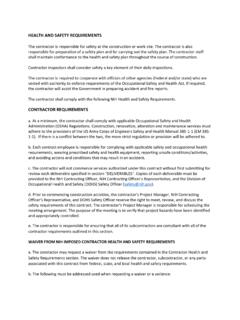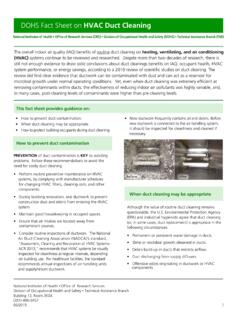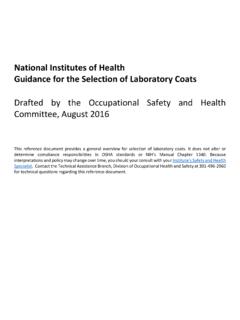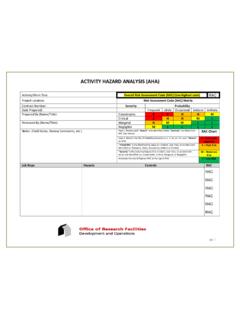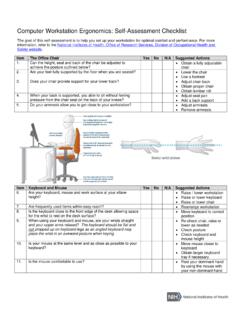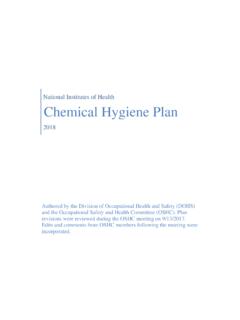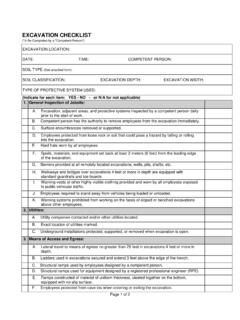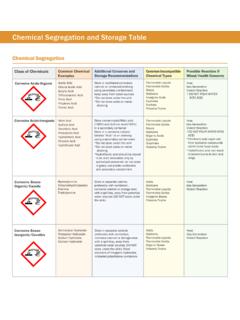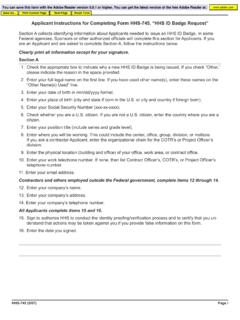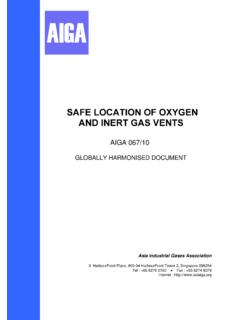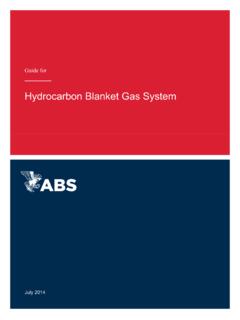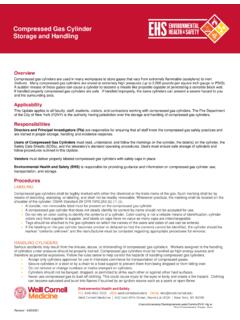Transcription of Protocol for Use and Maintenance of Oxygen Monitoring …
1 National Institutes of Health Protocol for Use and Maintenance of Oxygen Monitoring Devices Revised: February 2014 Technical Assistance Branch Division of Occupational Health and Safety Office of Research Services National Institutes of Health Protocol for Use and Maintenance of Oxygen Monitoring Devices INTRODUCTION This Protocol has been established at the National Institutes of Health (NIH) to: 1) Provide guidance on the installation, Maintenance , and calibration of Oxygen Monitoring devices in animal and laboratory areas in all NIH owned and leased buildings 2) Identify and list all device locations Compressed gases and cryogenic liquids ( mainly nitrogen, helium, and carbon dioxide) may be used in laboratories and other locations for various lab applications and work procedures.
2 Nitrogen and helium are the most commonly used compressed gases; primarily for their freezing properties and use in storing laboratory samples and/or components. They are extremely cold while in a compressed, liquid state. These two gases are inert, colorless, odorless, noncorrosive and nontoxic. When liquid nitrogen and/or helium are dispensed they release nitrogen and/or helium gas, which is defined as being a simple asphixiant (displaces Oxygen ). Displacing Oxygen creates the potential for an Oxygen deficient or hazardous atmosphere, which is an occupational hazard. The Occupational Safety and Health Administration (OSHA) specifies that a hazardous atmosphere may include one where the Oxygen concentration is below or above The following are some of the most common locations where compressed gases are found and potentially creating an Oxygen deficient atmosphere: Magnetic resonance imaging (MRI) rooms (or magnet rooms) Transmission Electron Microscope (TEM) rooms Freezer farms Oxygen Monitoring devices are recommended to be installed in these animal and/or laboratory locations to continuously monitor Oxygen levels.
3 This is to meet general safety and health considerations and also required in the 2008 NIH Design Requirements Manual (DRM) for Biomedical Laboratories and Animal Research Facilities. Oxygen Monitoring devices are required i n certain other locations under the OSHA confined space regulation. The confined space regulation may have some applicability and should be reviewed in conjunction with this Protocol and the NIH confined space program. 1 RESPONSIBILITIES Institute/Center (IC) The IC is responsible for ensuring Oxygen Monitoring devices are installed, maintained, and calibrated as per guidance in this Protocol .
4 A service contract may be established with the manufacturer to meet these obligations. Division of Occupational Health and Safety (DOHS): Safety Specialist Provide additional guidance, where applicable, on the installation, Maintenance , and calibration of the Oxygen Monitoring devices. DOHS Technical Assistance Branch (TAB) Provide support to the DOHS Safety Specialist in regards to the technical aspects of installation, Maintenance , and calibration. Periodically review and update this Protocol . NOTE: The DOHS Safety Specialist and the IC should review related health and safety considerations not specific to this Protocol , such as the safe handling and storage of compressed gases.
5 For example, because of the significant freezing hazards related to the handling of liquid nitrogen and helium, proper personal protection equipment (PPE) such as, loose-fitting insulated gloves and goggles/face shields must be worn when handling and dispensing these cryogenic liquids. Also, containers used to transport liquid nitrogen, such as dewars, should be used in a safe and appropriate manner. INSTALLATION An Oxygen Monitoring device shall be installed in any indoor location where compressed gases or cryogenic liquids are st ored and/or dispensed in manner that could create the potential for the displacement of Oxygen .
6 At a minimum, the following factors should be used in determining if a device should be installed: manufacturer ( , magnet) guidance, volume of gas used, location of gas, and air changes/hour in the room/area. The 2008 NIH DRM notes that both carbon dioxide manifold [and] nitrogen holding rooms and shall include Oxygen level Monitoring alarms (section 8, pages 8-80). Additionally, compressed gases or cryogenic liquids shall not be located or dispensed in any indoor location that does not have proper ventilation. The IC should contact their DOHS Safety Specialist and perform an assessment of the activities and area with respect for the need of an Oxygen Monitoring device.
7 Compressed gases used for instrument calibration, for example, may not require the installation of an Oxygen Monitoring device. The installation of the Oxygen Monitoring device will rely on the manufacturer s specific requirements and recommendations. Some of these requirements may include, but not be limited to, the following: 1) Installing the device close to an area where a leak would most likely occur; 2) Placing the device at the proper height depending on the density of the gas; 2 3) Ensuring the device s display is accessible; 4) Performing a leak test of the Oxygen Monitoring devises sample lines, system components and fittings As per the manufacture s recommendation, a low Oxygen alarm shall be installed along with t he Monitoring device to alert persons in the surrounding area of a hazardous condition.
8 This Monitoring device should also be interlocked with the building automation system (BAS). Where applicable, the device shall also be interlocked with an emergency exhaust fan or ventilation system that is located at the monitored location. An alarm will trigger emergency ventilation of the space. Alarms installed during new construction, or building alteration, should include both visual and audible warnings to notify occupants. OSHA specifies that a hazardous atmosphere may include one where the Oxygen concentration is below or above The device alarm and warning levels should be set according to these Oxygen concentration levels (a normal atmosphere is composed of approximately 21% Oxygen and 79% nitrogen).
9 Maintenance & USE General Maintenance /troubleshooting Any Maintenance or repair on the Monitoring device should be only performed by the manufacturer or manufacturer s representative using manufacturer specific replacement parts. Most Oxygen Monitoring devices require minimal periodic Maintenance . The device itself can be periodically cleaned with a clean, dry cloth. Sensor replacement Oxygen sensors are the main Monitoring components of these devices. Sensor replacement is dictated by the manufacturer of the Oxygen Monitoring device and the scheduled replacement requirements should be noted by the IC during installation.
10 For example, Oxygen sensors on the MSA Toxgard II Monitor typically last a maximum of two years. Some devices may also give a display reading when the sensor needs to be replaced. The IC shall have a program in place to track and ensure the proper Maintenance of each monitor. CALIBRATION Calibrations are performed to verify the accuracy of the Oxygen sensor, which is the main component of an Oxygen Monitoring device. There are generally two different types of calibrations: initial and 12-month interval. Initial and 12-month interval calibrations should be performed by the manufacturer or manufacturer s representative.
